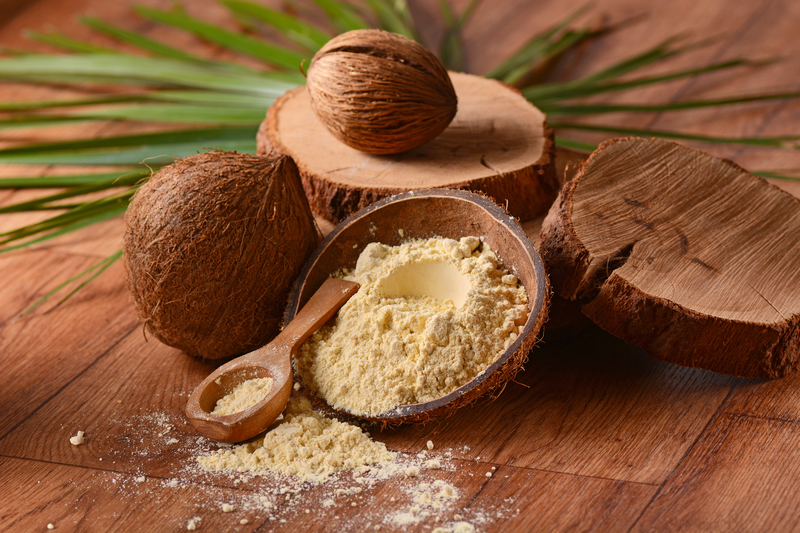Coconut or Almond Flour: What’s Better For Your Health?

Flour—made from wheat—has been a major staple in most people’s diets for generations. And if you like “interesting facts,” you may be keen on knowing that the earliest archaeological evidence for wheat being turned into flour dates back to 6,000BC. Yet, more and more people are making a conscious effort to limit, if not all together shun, wheat in all its forms—especially when it comes to refined flours.
No bread, sandwiches, pizza, muffins, cakes, pastas… To never, ever eat any of them again? That would be pretty rough—and is beyond imagination for many of us. Fortunately, as wheat (and flour made from it) has become the scapegoat, many other substitutes have come into favor. In fact, you can make flour out of a wide variety of beans, grains, nuts, roots, and seeds.
If you’ve jumped on the gluten-free bandwagon, you may be familiar with rice- or quinoa-based flours and others, but two that have risen to the top—thanks to their nutrition profile and lower carb count—are coconut or almond flour. Both are gluten- and grain-free, and they tend to be particularly popular with people following low-carb, Paleo, and Keto, and gluten-free, diets.
So, coconut or almond flour, which is better? Let’s dig into the health benefits of each.
Health Benefits of Almond Flour
Almond flour is made by simply grinding up almonds until they’re fine and flour-like. Be careful: Too much grinding results in almond butter. While super delicious, almond butter does not make for a good flour substitute.
While many people talk about almond “flour” and “meal” interchangeably, almonds used for flour have had their skin removed (before grinding) while almond “meal” is made with “skin-on” almonds. While it may seem like semantics, this is an important distinction that can have a significant effect on the taste, texture, and functional application.
Nutritionally speaking, here’s how almond flour and almond meal stack up: 1
Almond Flour Nutrition Data (per cup):
- Calories: 160
- Protein: 6 g
- Total Fat: 14 g
- Carbs: 6 g
- Fiber: 3 g
- Sugars: 1 g
Almond Meal Nutrition Data (per cup):
- Calories: 180
- Protein: 6 g
- Total Fat: 16 g
- Carbs: 6 g
- Fiber: 3 g
- Sugars: 1 g
Almond flour and meal also provide vitamin E, calcium, iron, magnesium, and manganese. For those following a low-carb diet, almond flour is often a top choice. As you can see, it is plenty high in fat, most of which is the “heart healthy” monounsaturated fat oleic acid.
Some shy away from almond flour because it contains phytic acid, which is frequently considered an “antinutrient.” However, this is probably an unnecessary concern. Although humans lack the phytase enzyme needed to break down phytic acid, gut bacteria in the large intestine produce it. In other words, the phytic acid present in almonds, grains, and legumes can be degraded in the large intestine (releasing minerals like calcium and magnesium stored with it), which at least in part explains why phytic acid may be associated with a number of health benefits.
Of course, people with nut allergies should avoid almond flour. Also, it’s worth noting that almond flour will, big surprise, taste like almonds, so it doesn’t mix well in all recipes. While it is often used in 1-to-1 to replace wheat flour, it’s worth following a recipe specifically made with almond flour at first to get your bearings. Almond flour can also be used to coat meat and fish in the place of breadcrumbs and is quite versatile.
Because it’s basically like eating almonds, almond flour offers the same laundry list of health benefits associated with this crunchy treat, including positive effects on cholesterol and glucose levels as well as increased satiety. 2,3,4
Health Benefits of Coconut Flour
The first thing you may notice is that the serving size for coconut flour is smaller (i.e., 2 tablespoons vs. 1 cup). That’s because you typically use less coconut flour in recipes compared to when you’re baking or cooking with almond or wheat flour, for example. In other words, with coconut flour, a little goes a long way.
Here’s how coconut flour stacks up nutritionally: 1
Coconut Flour Nutrition Data (per 2 tablespoons):
- Calories: 60
- Protein: 3 g
- Total Fat: 1.5 g
- Carbs: 9 g
- Fiber: 5 g
- Sugars: 3 g
Coconut flour provides calcium, iron, and potassium, copper, and other minerals. When comparing serving sizes, coconut flour is lower in calories and total fat compared to almond flour. This is not inherently a “good” or “bad” thing, but it may be something to take into consideration based on your personal preferences and dietary needs.
In one study from Rio de Janeiro, 42 overweight women (mostly in their 40s) were put on a low-calorie diet that included coconut flour. The women lost body fat and waist circumference and improved body mass index, blood pressure, and blood glucose levels by improving diet quality and lowering the glycemic index. 5
When it comes to baking, coconut and almond flours are quite different. Quite simply, coconut flour needs more moisture. Otherwise, your end result will turn out crumbly and dry. So, when seeking out recipes, you can’t use the two types of flour interchangeably. Coconut flour has a less distinct flavor, so it can be even more versatile. Just note that the flavor is also slightly sweet.
Coconut or Almond Flour: Which Is Best?
In the debate of coconut or almond flour, both flours have their positive points and downsides. Neither is perfect for everyone or every application. Some people prefer one over the other, but for most people (as long as there’s no nut allergy to contend with), it depends on the recipe and personal preference. And quite likely, you’ll find both are great alternatives; in fact, many people use both in the same recipe. So, even if you’re gluten-free and/or limiting (or eliminating) grains, you’ll still have options for the occasional baked goods, thickening soups and broths, and breading meats.







